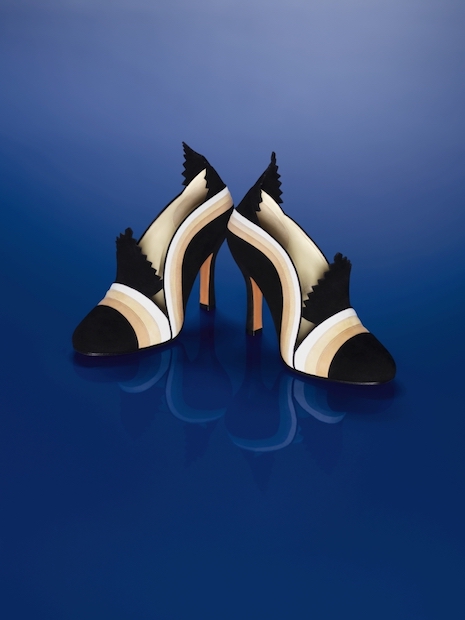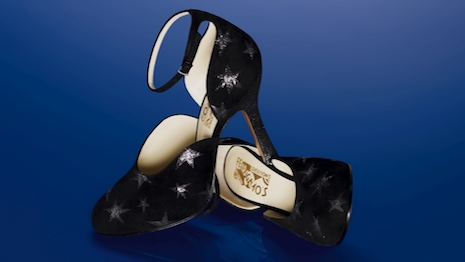Italian shoemaker Salvatore Ferragamo is celebrating 90 years since its founder’s return to Italy from the United States with a visual retelling of his journey.
In 1927, after 12 years spent between Boston and California, Mr. Ferragamo returned to his home country, settling in Florence to recommence his footwear business. Due to the post-World War I climate, Mr. Ferragamo came home to an Italy that was once again embracing national traditions and handcrafts where creativity could flourish.
"Milestones are important for brands to celebrate,"said Rebecca Miller, founder and CEO of Miller & Company, New York. "They create the perfect marketing opportunity for brands to share their story with their clientele and potential clientele.
"It’s an occasion to get publicity and provides a reason to make a splash raising awareness of their business within their community and to like audiences outside of their community," she said. "Brands should celebrate milestones with gusto, strategically aligning them with their past and their future, drawing toward them the broadest pool of buyers."
Ms. Miller is not affiliated with Ferragamo, but agreed to comment as an industry expert. Ferragamo was unable to comment directly, but assisted with this article.
A 1920s homecoming
To celebrate the 90th anniversary of Mr. Ferragamo’s return to Italy, Ferragamo is delving into the artistic experimentation of 1927 through a temporary exhibit at its Museo Salvatore Ferragamo housed in the lower level of its Florence flagship.
Curated by Carlo Sisi, “1927 The Return to Italy: Salvatore Ferragamo and Twentieth-Century Visual Culture” explores the artistic culture of Italy at the time and how Mr. Ferragamo’s creativity flourished under those conditions.
Told in chapters, the exhibit starts at traditional handcrafts and extends to the establishment of the footwear industry. Mr. Ferragamo’s personal views of contemporary culture are expressed throughout as are the tastes of the time.

Salvatore Ferragamo Museum: 1927 The return to Italy. Credit: Guglielmo de' Micheli per Salvatore Ferragamo
Italian visual culture serves as an underlying theme of the exhibit as current events of the day, as well as art, influenced and informed Mr. Ferragamo’s designs up until the rise of Italy’s fascist movement and its eventual rise to power.
Ferragamo’s 1927 The Return to Italy is spread across eight rooms with sets designed by Maurizio Balo. Present are works of art that inspired Mr. Ferragamo such as Maccari, Martini and Balla, among others.
To further the examination of 1927 Italy, the exhibit also includes clothing, objets d’art, photographs and advertisements. Footwear designed by Mr. Ferragamo in the 1920s will also be on display.
The exhibit opened May 19 and will be on view until May 2, 2018.
Coinciding with the opening of 1927 The Return to Italy, Ferragamo has launched an exclusive capsule collection.
The Ferragamo’s Creation capsule includes six shoe models created by Mr. Ferragamo in the late 1920s and early 1930s. The styles include the Lottie, The Star, Autumn, Labirinto, Preziosa and Indiana.
Styles included in the Ferragamo’s Creation collection draw from the brand’s extensive archives of more than 15,000 designs to celebrate brand heritage. The brand describes the Ferragamo’s Creation pieces as “feminine creation[s], perfect in style and detail, which goes beyond a mere accessory to become an object of design, almost on par with a work of art.”

Ferragamo's Creation The Lottie, part of The 1927 Return to Italy capsule collection
The Ferragamo’s Creation capsule for 1927 The Return to Italy will be presented in a bright blue box embellished with a gold plaque with the heritage division’s logo. The shoes will be packaged in plush covers in the same blue hue as the box.
Ferragamo’s special-edition packaging for the capsule was inspired by a patent taken out by Mr. Ferragamo himself in the late 1920s. The packaging will also include a limited-edition certificate.
"Ferragamo’s capsule collection elevates a profound 90th anniversary of Mr. Ferragamo’s return to Italy after 12 years in the U.S. by bringing the essence of 'luxury' to center stage in partnership with a cultural institution," Miller & Company's Ms. Miller said. "It offers vibrant storytelling visually by extending a creative nod and a genuine and thoughtful embrace to artists, history, commerce, design and fashion.
"The broader the artistic reach a brand is able to attract, the wider the pool of participants from which a 'limited-edition' will be sought and acquired," she said. "A controlled frenzy will emerge for not only for a fortunate few, but the verve will have a rippling effect, which can quickly be monetized."
A legacy that lives on
The creative mind behind the Ferragamo brand is often explored at the brand’s Florentine museum.
In 2014, for example, Ferragamo’s museum launched "Equilibrium" to explore its roots in footwear.
The exhibit focused upon Mr. Ferragamo’s studies of the human foot, specifically the role the foot’s arch has in supporting the body. His research in fields such as science, art, architecture, archaeology, circus and dance gave him valuable information about the human body that helped shape the brand’s shoes (see story).
Mr. Ferragamo’s creations are a continued source of inspiration for the brand.
For instance, in 2016 Ferragamo worked with handbag designer Sara Battaglia to create a leather goods capsule collection that celebrated its founder’s colorful life.
As inspiration, Ms. Battaglia turned to one of Mr. Ferragamo’s most iconic shoes, the Rainbow Wedge. Designed in 1938 for actress Judy Garland, the shoe features a stacked heel with the colors of the rainbow. Ms. Battaglia took the Rainbow Wedge and reinterpreted it as kaleidoscopic bags and small leather goods for the modern woman (see story).
"Heritage brands work diligently to remain important to their clientele, continually offering designs that honor the DNA of the brand while embracing trends and often technology, using only quality materials and employing artisanal workmanship creating an aura around the brand and products fashioning the desire to own," Miller & Company's Ms. Miller said.
"When a significant moment presents itself to promote and draw awareness to the heritage and success a brand has earned, it affords the brand a rich opportunity to attract new consumers," she said. "The inclusion and partnership of other prominent entities further expands a brands ability to capture market share. The combination of varied stories, education and desirable offerings act as a natural financial multiplier."
{"ct":"lNRZN\/CcwoejkoEQLq\/qf16Rj08\/Ev5CCyRxkqpDYP7GcTn8NqtSRJEfxNUFu+4deck4IY0R80i8LDJ0X1M4k+5oQ5HwY0OAAnGERPsJWOxDajD9Vcr20LVIthy0ARwjYRwMPHkfmj1\/cwo8\/QexvM0MDMQOt35jm3PCtaR7O7D3c42IjRQbDFzahAHtKkgDUbNz1d6TGk8eI5PBNQxxJ\/90oHpXBevlWQ7IYThQHsmTMNQrGlJ6uetPM2rp8+sNhzwYei5owhJfbD66b+o6v2fkDPzV+ep4bpCdWQ10cGXWClsT26y17sRO8cj6kPuY8iJCYYvzqCdhMIYjSIYJ+\/s9BJPiSo7sjdMMEBXkDNKWcxyZdm+n\/3317i5t0Aye8bPOETk8fQ\/s3xHpZSBuBuT3Jj9uPPGb4ELTCpD5SRZoLn90FB36WvPcq6Jf2OETag0L2f0NwF8f0I0YPOC5IQ6kNGKxi7JmSJVjCRgk+fY4pJxJ3Wg1Wsbd+QqMJX1DRPBTZKctoGpbx6P9dCV7jJpDbbTcIR7ItmiOyd47y2JAMxUjF9CIWFm34ZkUdCuEDZLD7+SSfNsS8NMPVfD+ZLU2sFAJiABSpiMoKVODBFbkX3Vu2XtNPhtSM0ociqf2hk1qdNDsjVBfa9xi1lYuwAcJymGd4WwyNHZzuELnkdkKHy474r47gJkqT38aJUwwe66kRTNs124ZrGZuTck2ibBwRvpW6u2KlyMGJHCuidomvKL+u5KcWEhCc73cuaoZ9Xo6tu4Pkj4Ihz\/FCJ\/ukUs7PUiSQiJGBLkFHxrrwYHqhQi1LOftKMW84+h6Ee1\/B7ob+K1rCeBwJ46omwlZbiL6gNxHFYlWKhERgVRe8hu7TpPWsZ4prBrPudwxllB6v5EmaTBSbRDMZHm+OtoWNV9PSDLJt7XFSMsO2er9iX3DKnFVZ33iwsHbisF5gwfZNrp08ShWYibLZXQwGw0Xo1B9U9pRMHjB2v5l+LMflI1Pt5U7UR3LtqEcW8J41iSwJMVQdil9yr05j2z6R1naSDQFI37byiobX6y1XkW5hwi26VkAFLT8Hu5gnCXbM6vYB4xlOuyboc9PhdvRw0VqPqupO9WDO3XQlOdmJux+LVGHMWvtHAh\/NUKkwHfSm6ttTxdNJx9qwTF2qigBk86cLwu6SjqL27vXnMl45tDSeelXiPljfDi1WOCBCGTs6Z7he+xCMmUJX2kYizIc0yJs+6MhBGE68d2E+D2JGSDPRzZlb9iVIMCtoalTqxsg3Lw7lRgFiJqJJ0DBRghZoMuKS1u52gd1rKTS9iHyDVCAtH0ELYs29neXsg\/KtocZJmCrQXXEH0VgY6covr5bR7UFdqARBI61Iq7xsJ97hd6yNdwWNuV0fgVdWslflxHKXsE9DfRGONSLCzJOB\/pDcspgrGjjNRQcYhTLeNeZEzxQ0IcmvAuO8Jujo83oz+YShYyKivpRNgaXXnEDF3yzC1s93Y5ANG38cKAnh0UxdlH94hDmbh4G695CVgNpwapdChViF+wQ9XFqXjOhvBaC1e3j9mCrz8KkUNulLiuHKpuWfpVm24B7U3q+QJtrlA+VeIkPuz7HL2xXm4tbXvnDWQln3i7Gn\/ukNj+RYYMjQ2QqhL4gr9OZKjuku4SHDLlfz+7A7jC+VENwC3JGxLGiXaCEZKcY8JQd3+kiRikvyT2JdPrf33s2xE9mhwq0ThsnSCFDO3EbLiZC71nizcPB7\/mkFiacdyAF34lieZK\/TnOEVAo+ytEn08PmKZMInuJ4izNh\/+LR85xMYdinUmaFPO3CbyuoLV7k7Ki3bTm9Ev5tDQ7UaX6Qy5vQ2GGzYwtNLaD2Ut\/H\/7qBLOiPVMp1g9LsM40Ojhq0U9V1eLXry75i0ReCVvKQn7\/6OGogxStgu45Twb+yL98Uja3EWA3D0kPMuQfiXgb\/Xxi5fiQNz45ekZinLqPFOAJSa8rjSD6\/TpVLlC5HCmolzKtITz9hQ4BmH7Crn\/j06i68lrinU3RPw2H8TaScKRd+2pc\/JkZsEfVYI5f0N7SWkzSHMuYcavVFa0t8ZfUA6rgoGCyXIn7W7rkCwA88WZJASBvw0cHbR0PJ1k7byYuzefBTcwuIkf5+Kn+zbYKZen\/pr3scW6gQnRs7StslxJBSnxJS6Le0deehr8zc52agfTQzjPYjk2w0WtNg\/yGTg5IgV1hAUpMEz68svBy6Mb10EEJCLiLw6Ghy4ffydQP0CpbxRQbr8lJiaErl6Irpgk6e7EbTggogJkcGG6J\/hD8uRlGryD2JqQUvYzSm00g9nHBmM3uGqMKqkukDOVShLDXjCMZYNddwzGkOKMVWpP7d4kiPCWpWS2+dkgzyxOhk\/MHPHVGFxLhPUWUmbDZSvAXj04NVDFe8uRMNwoypfD3AUu57QNrDuQqaeHcGE6CVbt6+2V+z9iDVr7S+1xsh7Mcso1sqrXoNEFQKeAo5G1FTEtixPeeuiu\/BZfvNJbXNKNHFbz2GzWw+j6RDay+qDH4yF7+CL\/SpOPHhK3VztpQ81btP+rN32GlG7uqsuF5u0Odb+IIeRGLtiPor5lUXyxcv864T5Hdxtcw\/GxLmGhr5HtkCmnItERT1cDNjY\/CByUU6HN1w0WBnfeonyyNBOssVGXAsiXJ0Ydcz8\/Xaan5FtR8a0JW4nEqLoRa\/BFAnRZBkBdpB0CH2MwP\/Z38iQgqrQk10AytJCKpJHbAzPGIcDUXv6LP67YXznOoOdvr09ddTQgvcTtpQzMzOHmgtKXOly9KNFm5b6vietyHjV3zEIwGxSJ4pSGSWqjgtiWBeYURnWF\/FyqIdPNsZB6aaEM6W3cLTtn8nShcOr6UI06I8j2O9OFxI6kjP\/F93LdisP5+MOGz5yGduvau9sHj0z6\/YcUViGf4hsy6mRsuGAS6\/DuC2EmeziIFenIEHhqSHJ50WsDZ+Pz38uvNO3QnwKZks6EwWyoslR+BZzmxxcfyVL9p8HtLeM0UDsnrqepV0FtJpmymeJ63i33WiXTr4tI7eQl66ptgJGMKWxR\/F5XyGUsXxWzdu3AdOd9Y0zepCy24fbix18viOp8BEiqL8Qa2wZ7Eqy03\/ue\/7DRI\/mpZIhbn6q6\/qeZhVQfjDx+wRQLRepvxTsanO0dW0B8m2g3FWc4Z0o9tvEbs1F2BQL5JyCC2Z26SHJvrv2IDwdR7KwpeZ9SLu2bzl+xX9yOj0QDvDYLe4XhIVcFshekulEmugaQhz5JYlJp7ojIDQWLgR\/J0ZQtIbhVn6KeiLzsfvZq4d5TLJ1cVi+Xt+9RVINGr7RJO\/09w5arg7I+zrpUHIoHV\/UhY6EH9bhQ8uA0QEav4bThv+e2Ldujzk8voTXSHa0k9vXK0batzWjo8K+p9AXbY7LqNKE8cvd1FKTSr+Bcst2i+0YE1VZwCPlsI6o1AL0BpekDZLibd5zdVohoGfwM7Lq4bQ6L75Er037iN7DdN2v5oZhd13KHfS2wy\/PF5Sw5ZDQw5MMI8iJ5eUYWBEOTlNeFVlzO3Cg8vorfcE8VFHtZb3EFHomlOUXtq+MrtPeo98WuNKuAe\/dNjDhABECeyqN2fRzd6+6DUNg8HcDP7wTnaWjNbVcaCy5yiLp4l+VF2mNuLXcndHitCmv4IYeLxWBfh+iEt2eBtcDUs+JTOyYH+NYOemLZCJzSkFYSAqInHb843CrqSdClmHSJpfT\/eQ4z\/m2\/csufDS0hCkRP814IeBHW\/kqzOSalzTTekHIp1i9f7RDlidbNsbg4ijvbyARg+zBepIJ5H+OrbtY5\/n7K4HivsUk2LBGPEZUOjZzdyvekaXWAt41i\/w7z9\/xIu6dyhB9dDD01+ZK9Rlj72RLx1ecgo62v+Ahmz9TUb\/NFWRjL7YaNQ0ctZIhO1vpxNIklqq7yw3hTGBIUf1p5VhCkXeZQkTdDZEW5DmaKDiNryuFJ33GFI4nZf7DLAbJ3JI7tmf+fHThfFO\/kB6e5AkMfkTUV7R4AGgasIQh\/\/GhKGYq6RhdJ4Be8AW4+shmWGhddQKveWHMVPmTmhHpzY78Ypc0aFCBAoRanYYq8TM9d0TPjpTIUmck73BpY5M4sbriabiF6oUdH0hmlIM8JWxCWuIN5iqz6UhHBkNox0RiMIO4O2PZLCr39GwLsc0GBjYMUs7B8mcGHvFQsg6Vv46jxLjRpk66Vtd2jA\/04PV8\/02weZ78hTTC1n29xHqR\/ubiAmLL3EOroONnDbYMLm8UxqcAbSYgVvIu7hKoKC7cf3O0xMadIlueu0K5+dIggYA2eXYWpFfIFoCghegfb0QB6LUMp1bQddpEpm\/R4J5pSDUyVf3lSoXMuHi3iHiE4LwIio43SbdFg3TQjlu462U\/RMo683nUxunklh3UbQwa\/+T3NE4Z+lvd+3PkKURs6glNmWrmnSsga9PNB9vGraoqvI7dmz0HGebzN25yXbXr3hD4N9IEirs94d5JBe+x1R33Ion3CZjevTQxAvdlc05MQ75sK+RPcyKxuB4HakNqWpFeJyFC\/Vnbgq649QwvgLzwaMPb2K\/QT5eL9eANYSDtWGR1+WPDT+n8HJqQUo9jbZyjJ6q3iQoqFLrmAeSTlApuh+YLzllru09ck8LrXNs6xHDnSk4Ffv1MNyrnLbTS1+J2MEwgQh2Ebwkh7kTRP5c3RgV7hoefpuMpPxX9SZTOD3qddqfSkWyDrh4vMDfDbwzOChMlKBrToM3p3f7Hh\/nZyrAfODcicMN\/+8yT57QpN8Blp97gE9r6msKbbV+cYEnRwoo9Ydu3PcMS4ouUWLBOCrOShw+RKNu7t+LQAdeg4TcI3UL5egIFHkTrF9xtJHQc3HoHmQ61YLUigXRD+zqI5ToR5XASNWzdaE6JVNdPQE3VKHLG4OcMg70WIarYWYW9kylc\/DVBJGh\/1iJXE2zmDnZ7Md\/Anei8MojXEKAkc3zIRVn+WUrHVsuVn5lHiwW++W1NSArRqGY8Z+Mmzyg3pr4kvXqoKZ9YAscHtvhc+R\/1GwDVX57VWK5TMcMB9Nn4AvZEk7vqIJTaqaA9llfE16FIRorwjWp+feXsUXuU3WetRsMy6rG5ntJJ+mxNgZQAHYhB9X6Qjd1iRmW8GefhW3XvsfMEfsRq1mawnw5d51fooxvNVecyJq40lpMe\/MsdMBagONWIGu9pUAM8TE6hURGS3IeZb5PdesT0OObVU43yG32vgQLNKScmkG+B7bo708Mneup6jOqCgNS5SCDr8UIfpFUnDDm7PXHr2Sh4hGfJ9oqa1SjVX+nN8Ix8NcHiQpyv6s+6h9Exy2PkGk24aOocdivkF+J4GirrEi0fFCj32MMwLh4hIOPT8jW4lz57VP8EMEWmcIVJAyTwinjcqBm62WiksyVJ70LSxQHR+ZrCs2QeqlIk4dm0zhVqWOoK2YsDuy8dEc5pGsa4Hpry7AhCvKOIjO8LPNC42X7oVBlpLTdC+U5ks1mkwZDxEMf68SE5s7BJskE1XKukdxHQKbf2gGrkE\/tUM6YvhU\/XC5295zTiUdjAQEh0Lu5Eg\/i1DWIcPgZbLTNbjrGZO3Heqz1PBGWY7EJAEGUCCIbBq9W9UXk0G0KGCTgNl4+iJU0XgaXCvDpOQ3F0dhgWjgGOALqMTO5MM8ogrvEDsCfZ09JwZBWtGIGrD6ujTzm3+PceFXt2nBVCx3+dqVPSlF0fC1h4G91PtCTgLMLyRMQcUELc0dK8bQslzekfy6e2yXkivDlUXZ8tIFjvoqqx1xj6otDNKcG9okaqSi1FsqiRPva3q1w2Fw+H5MfZc1MIHVtYAO6+2hEfCGOXd6BFlTBQn+SHYGMiSxgEU\/fN1VwzLfdJsZnIJy9vyn7KjxnodOtYcIb\/BkKfRNM4uZKMfI6jNoG+eWpPvAQ5\/ycJpA4rtlxqUUFO1ug5VLcLfymY2iOgkVAGu4Zhn9HgBUN79SZAN6UudKPNKgCdaE8WVRj8zeZzqkXcVmDoJRMV4gizHRAH\/E7gbUJjgxJ3L6MZVMcNQJdLH5d2h1dfjSUjdWCtMCN2c8Fw3ViXr2NWpj87KDIHIGB2zBER7pIZDhVEqqyHxHmjm1Nz8aTNt2e7+YmPZOqSElRtoTMZ6MTouKhhOy01iOCAqi2HJ79agMIKEA8iNyhOaXjga5ObKc5nsLUOcs1KYqSUNRFmkRbvVZsY1nQr0yX1IXPJBDY+f3JWf8HxiswiE7XqxfzBXkWPKagCYDZHCEDDlErnhmlrKjEKuK7YLHdcv315pPL37YPR+N2sTSO\/nzDSVM87wQmI5DIA8z4TG9pIc7CcVYdonarEAIw7b9y\/qqqLshzYRrxCDPPHPwqliKyCqm+TbIR27BcopeH5tfQYJlIRB5qBS7jXTnEg1+h0ZOdUOs4Py4+mWAQr53WyzpXmS7qxIkrJHVbLG85E\/X9XnQiRBHRk\/v5Zpltc7V0bYZ2CkifSNFq+M2PacPziAN6g9xxxUA0xYa6W0q4FjTyhsOHyWm47RboG4s12YozC0HDnXMCaMgh6iP2sOw8lfWsVxB4BbU8jJ5bGHhtIJfQnMhsxKZJ3tXGw7ABn2c40LqJBw4JLujGalgF7WWLUTmvkGhFM97\/ivwCgUcKErS2eZ++8JGZk9Aq9Sp6H68KeqYMt\/JXj26aYyldWO\/D\/7rCwP5UJ1mWcBxTmSFMd74DB4QPZbUJ3u1ifKea643MrzssyBcc8zi9feo+v0kHmzmBQLLKjzNUN5WfKtfPFjF3Kzn7vI5c3BQVV0b6gHqp1dmLRrtRPr7kyRXRB+dCs721srzMLtA\/op5FL5gtb7PEcE+EXmvU2QKtVENMn5S2P7Pdadoi2LVntMUtSUJekAp63OrOSDJ1KlDvs2aQBmvq5KfaTggEg7jzSGdESLv0\/MUrs\/miqUvraowhOU\/MRYJ8VFAotpxYCl9OrS4p3mG5DEOLZGAcatkGMrtnVxwfCkkO8JRKhfEiKm\/5ptqDqDeRBqiD3u6oVJHpiGTGqY2troBqUipTbNFOpCDHp6BR3YqZo3tXXRxb\/N64Gi3PsyRAauU5luBaVMee2uCYw5nOMyRq7TgKSInFY03fgpsr22sgOPsLdkT5\/fLEYM4hrrv8TjCgeccwj+A00YWg\/irsliANY7F3I7PEuerdXMOGu+CLC05DuihDancNN4omnPTQfTxvoUkKQxAnPzKHXRh4+L6Lr1rcugS3v8dGn1aopw1MZL76sN2Ec4J+uufl4Cz\/RB+V8\/oYI+D7Swf66NHZ9jbq1pmIIZn1ZMqKeLQcT\/EV6hUj3hugfikT3KeSd6VRfS1gsTWuuJrzJRgy0mTNDN0f\/tBYIgD9TKU970dDaM4vfjF3MqNwOYmER5BaHGu8\/8XCKPPI6A0fqbbIuTNajwCKntiVyXg7HBDKgQPn8TqBx741Nyc3JZgSYS+gZRKhSUkQvPfxv4krptOsjjE303fKoAs1Efhv94K5dYiCX1MF3j7yyx7RclpvCKafz3QpOulGBFSAGIKHd5u0CzY6qFKXXtL4IkyNEMpmCnkzoj7PrgqO6kXEI9eYAXJ+z34tcejZjR\/eFoby4fk8uGvwW2bXeeJqgOtdhRtHmxmFqAy3NhLgLf9gFM0CTMalnSvQJDhktAlmhKI\/+JeH29sLw4tYcJNjNM70R0F861CiDoFbHhUaWmhqzCxO2Ozv+3c4bZ8s909ETJ+EBz54vpTeCys6me2wYCSnYUvoE1MvkcNjn3piSd5cxz10CjX3Aqzaq8HGqRK5lBtt7UDGSxMj9GHsTBoIq9y96W0ujSKFyNVXY8BcItSdfv9\/0\/rsPYiownwOa7wjL5j\/NdfJjBy44g2xDR4BERSg\/Z57gTISOt8BQNWQzEuzAu92WegjuQmpeSQTia6tSh9o8FieXBFtxth9rbZQDeA2Kzm2N30C5\/S7pAUAEwj51UzM9p+QD7aXSxto4mXnfeSPnj2JZbzKmjMFSP2cUgNhi3kElZ3w+LmEL6IFt3iRuYgfRtz2h1\/HLVdods0MjoqtuI9jQSWrbawwYY3MLIVX2av9DjJs0AmyUvqPa1fURFj8INE2qHpNbKv\/e1Z+XCj7Ac4\/xbDDIt6WFMSJRxrsdjoizKxoNpbl5klqiqukh7eusBUhDW5FOKZrruSGGtwA08pa4iGBWmq8RyKFXIhXbXCdzyjyfvx59QNn6AvDXfjtUMDxchUoOwC4ZrvQkSY5duJpdyjTrTYS4dBSf9ggEL\/4Ape3FMcKIEyoFw71zNWc45xeymyaEi3XO2sRMZAEO+rGhG6AbZ4P8m1bVXz9jOgcc6CIr0ILqLPTUgQr5rwbL5pVZ2sunEMlLEAkOGPUJ8QMCMyCoTHdJEjE9y+U0bHt+UCyKelRQdtskWs8CucAg4TASp8LZWtYdh4PcumYwjYU0Rp0mQg\/J1rPiIOV\/\/bntbgramZuB7wYWwgBOPo7e\/OXY9YVu2xfAGxUl9kfVeliZtQ0nxmo9ell2oeUMEDR49Qpr85qwCZPvvGfEb+MgkiRJljjSYaohNZaSPoyz3kjiT7UXvllgNwAi8Qbx5Dk4amiK\/NvwW4klZFsIM1PtSSuOmqMBadO\/CGqbCgUvRWJSKC84of4hNkU46e9XVEU\/dGhzKV9PFbGMUr3l1g4LkX\/tNgnlvcc1P4Wu+gPA1+68d8eE+165RQzZ5eEfHQoFrmXs8szPMPYD9Evc+YE9YofWfXBJ9a1ajmUobeiTXj6NZVKBXq1zaG1fjQkqGyfbCCouvm6lAHDeAt4B05aYA5cBBywsrDTEsmQmV1OTFGPqFdb9iFaJL2H9wduLqaPql1IUQGKLwmIDHFUlCZvy+m1ihM+sK8i4U\/9kFcoziAUDIPoBljyhRM0lMjPkn7Bwc\/xlpwbkgiE0rZKOR9c27e5DYBiOu1Y5gg9VN6Q+RRTmdnnmCiVLO6pdZrQ+9r0W5xScsSKypQdstLX9cOMRaQ\/MN7P5CxwjSV57eblS55EXtI+M5fMmvDM9eYSmnTJuxtMZRYVf5xAxbmjDkCKN2vZrwm0Wtb3Wp4rptD3XW4xQLlx5jaOhOKNDsLaY17Rw2+7ARvVOUS1bNCbVPOOzLjqaUAVJXeq7rsrfCnGjTHSjVjy5FKQlEQCEujI53PJTHTvabE0uq5AhqYrCnRReqJmQMto3EitoJzgT19EKUTHhGXcyMT0Fjybd0V57z9J4DIRL\/yGfKZBpVVDKleI+NSaM1t8mjmGDtewiYD0E4iAfDeAHNraBYwh+rwXkTVROCJLSifchSm3GudNhhtOgVfkntezkbb4Jmzb8YvBbX4bipgx8gViqyzBg+Xjk8SFe8tmKvNR0CvFQZVPI8HE+LKRFJ2IM2VCUaOoab9fKbx+GwnC7QjbdRoGjBCX7CRJbjJiHFKjeTMFNbClaCY5pydJOXx5MiWDDovZBqOT+TRK41W3YXzTT0r4SBQLvcVLIE+S4lQcYnCDLHjGz+1b3dXUlU4rQ3GqoPrm+hSGZ+vzZVmuwzYgbaShdiBEIWh8ihzODkO5lbiYNEpGOArejVF6SkSManpelwh4Bm64FuVftmVpQEKtV4q5FAYGRZhxj9TECQJtPg6HzcIFxLh8LJuf\/UO80\/dAquZTbNVij8hlOli7BEBAsWCffeasjzZ62JsS2DT9elcFBhJ+RsdzYbKhhkqk4vhHt5Hrs96cNeGqA1jrUdxkVnsRMclMWb79I0fuZGIyxDcP3bIpr\/nTtC5QmQWC6iKTIM\/3k202u6RFU\/EW7AVRuN1fzjCHxFtOcv99ftyXS34aNH4N0QaB+VSQ5gcTiyhN1CzdWmVM3jDjUcsPTPg6TY1YCzDPe4\/JqL5Qo0kscLJptqXnsKFKCFcGTbCx3UoIkm620lDCnBakb6WqQVVa+oQZ9yzALox5GgUmEHwBi4PGLtuvBUOAaYibTHeBuMf9B7euMYz7zJ2xXNuecPSX1hFahEFkJrGDuMUVFpXAEdq+gVgG6S7Ft6VdHul7lYc+s+cdZxLDOuBzGw6gG0BOgrGfkLu\/9PqULPk2vRoXdRJYnwaWGYGaBdQXnptyxVIcGFxVGz8i+WqMYK+UJhewazpqBYKgq7kgfiXiLNp9QCa2IbTumQQ\/l39r4iWQWMMKQBOXdLEe3f6EYrIAzvPVGGIQfs8CnNtL1ZmMWneriL8VTaVHTM7RpZSd+t3zYElvF\/es3q9n3IHLEWR6vEKSMTvvRNutZY\/BhPyP7JsjeEeaMiN7bWyLt0P5Y22DZBe3RL1a9ly68WppSR59JUuvUA132mJWSJN3C409Xasg5DD9f8sV4e\/UF9ueyZF9PhYD1DNJaf0FZm4r84QiWHcRRYz2\/gZ1fBB7kT5DhVoy3+A6LiKA6sqBMqQ3dsYNEtgcXWhQgcKPL57O1587sQgvTpDuO75iVQuDR8VtJvzosum9Pfe9ECrgCOj74T11z1o0\/wfDBOV8fehDNfW9JoLqMUJZ0nn4A2ZCiVCordcbAz+UdRZukG3KGOgr0kEizhXRBxbrglxpPUCNqzmO3rNiIiWsOG3YKJ9ufpgj8RgxcYYZZjj02+NV049h4VAWpWMEszcoujLl3jD7Zmn+oiW7Q13h9mxHVG4o2qet3iJdBCjDzQ8SOft8R6izL5XLaLxK24bevAj4JF6teeGeP\/H9bLG6GgEfSI0cApRJY\/G8GNAo6d7OTWVa9uobDOBxc\/sBEZjRlE9Cr9yvIfpDhFA2xBEKFG9jGCYA7iGhsIDCaswI5DdZ3AvWP7fkNCkUeyZ6jvhSgJfUW9fgkhAes382ucomRYuLUyJL92zYITicIO2FV6QRlZwp53CRztJX1d03i56euAJVCslJFqYtAwnoIsf+pbP\/xxE6vEWvjBGH2xeFXHeFwP1ym4utWwPNggeaNak8THTKkx+OagM57Ehq6uuZaR4pipQwfnaxLqJujU2+97hMBs\/\/nfTwNVmU1kALBstIYVt8Fw3k\/ZQ+0Iqh9jxUfrqQ6+4rf4Z6xOZCI3nfHnl+JTeZv9sD\/rRAuaDD+\/f1o4wBfESu5UTDewI8SzR\/WCqYlkpOdtAPXyX+YBYpSUKAmwPOeltFN5lkmyKXNuMP8paMi9pPV6CTkQfrwki+UnFoWksoRh3eo8VQyMch2Hm3FJORfC3E0w2FkTvsSKibXWAXuk59kESoRwY+dcogkACosGy7+Wu71jg\/i6VUIzEz+uS2kDxdTabLa9L5yMuiz7z8BHQFJZsLD4zIYUbxHJcQdRKw+aluurLVLIGmZD\/y5sltPwI0UDmDqie2BPSTD\/wrH1I99qlHxQsjjB112rcQM\/XbIcSyMf24jRYJyw0Vx1ej6a6IJuJ9ky5QR\/yPxXAYTK00FlgkcD7LyHFWzKTsI4dB8aK0AT0wGCWpTUiUIO9nAGK8agYxFdJ3gq96EJYxfr7CwFlPTwBVgjGkeTn5zGtJraUJ0PGvrxELy+M85GhKUR4IQR8xC8AYd9oLRPihMwmXmb5u3VrzVZ0YvcUUd6gd2KJIlQBMZxlaFehRmFJIdVdX4WWWT7i42IpUTo3z2x+2Ps0S65xZKAtZP3GTn9YpnNBTY7BGwhKn\/L\/Al1CXz8ZqmftGUsvQ\/HwSUM6dH7QprE\/JqaflCF4YRsk5s4b1hvrC+XIn","iv":"8d551a103411dd3c6f19c81e6c54da37","s":"0f64c95e8cdf75fe"}

 Ferragamo's Creation The Star, part of The 1927 Return to Italy capsule collection
Ferragamo's Creation The Star, part of The 1927 Return to Italy capsule collection